OPEL KARL 2015 Owners Manual
Manufacturer: OPEL, Model Year: 2015, Model line: KARL, Model: OPEL KARL 2015Pages: 217, PDF Size: 4.16 MB
Page 141 of 217
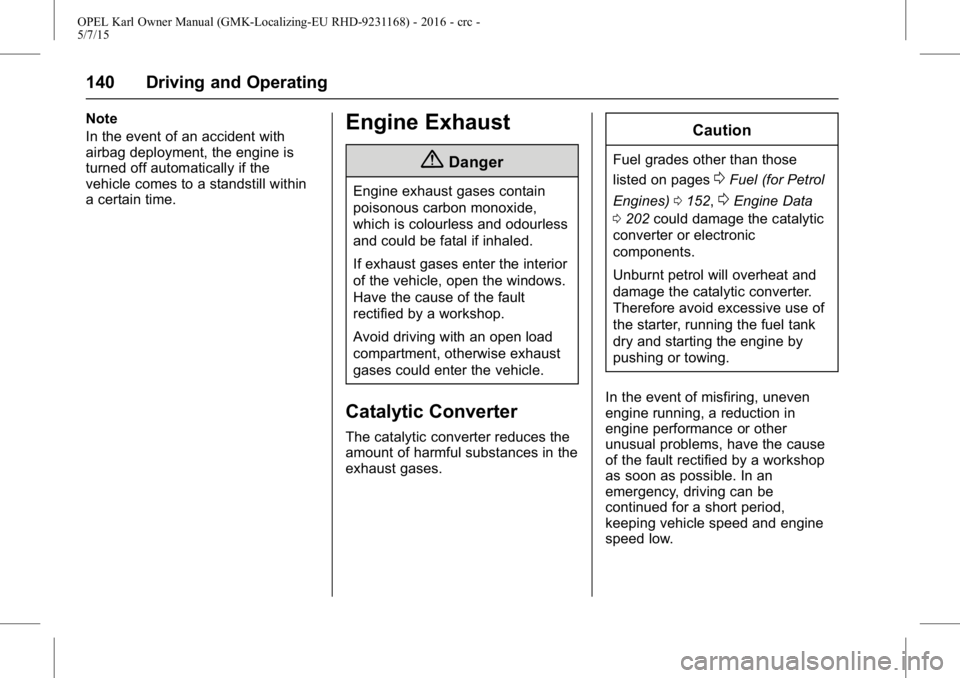
OPEL Karl Owner Manual (GMK-Localizing-EU RHD-9231168) - 2016 - crc -
5/7/15
140 Driving and Operating
Note
In the event of an accident with
airbag deployment, the engine is
turned off automatically if the
vehicle comes to a standstill within
a certain time.Engine Exhaust
{Danger
Engine exhaust gases contain
poisonous carbon monoxide,
which is colourless and odourless
and could be fatal if inhaled.
If exhaust gases enter the interior
of the vehicle, open the windows.
Have the cause of the fault
rectified by a workshop.
Avoid driving with an open load
compartment, otherwise exhaust
gases could enter the vehicle.
Catalytic Converter
The catalytic converter reduces the
amount of harmful substances in the
exhaust gases.
Caution
Fuel grades other than those
listed on pages
0Fuel (for Petrol
Engines) 0152,
0Engine Data
0 202 could damage the catalytic
converter or electronic
components.
Unburnt petrol will overheat and
damage the catalytic converter.
Therefore avoid excessive use of
the starter, running the fuel tank
dry and starting the engine by
pushing or towing.
In the event of misfiring, uneven
engine running, a reduction in
engine performance or other
unusual problems, have the cause
of the fault rectified by a workshop
as soon as possible. In an
emergency, driving can be
continued for a short period,
keeping vehicle speed and engine
speed low.
Page 142 of 217
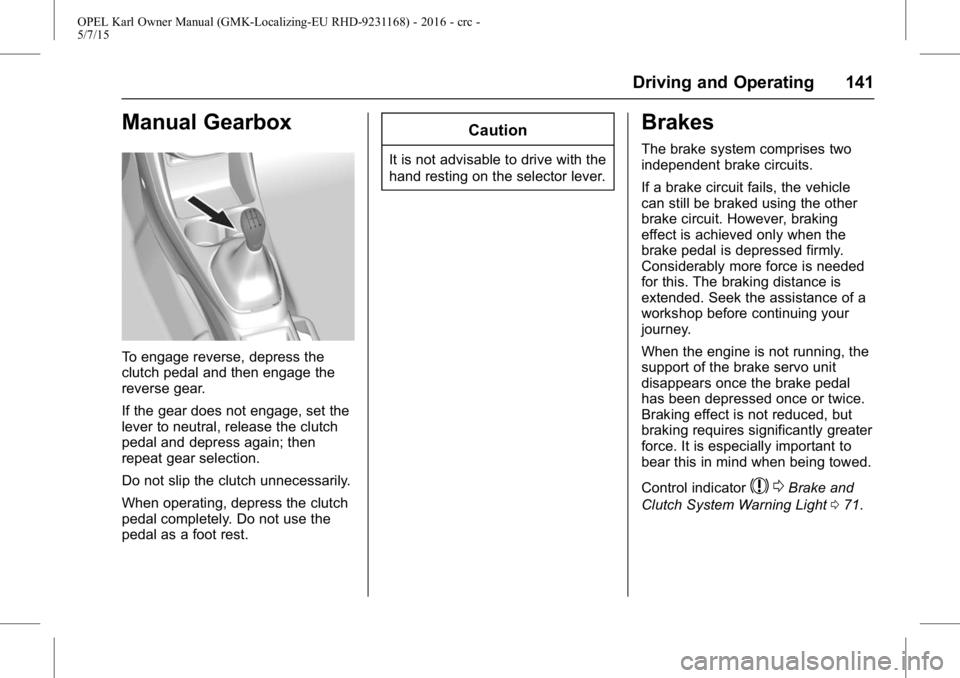
OPEL Karl Owner Manual (GMK-Localizing-EU RHD-9231168) - 2016 - crc -
5/7/15
Driving and Operating 141
Manual Gearbox
To engage reverse, depress the
clutch pedal and then engage the
reverse gear.
If the gear does not engage, set the
lever to neutral, release the clutch
pedal and depress again; then
repeat gear selection.
Do not slip the clutch unnecessarily.
When operating, depress the clutch
pedal completely. Do not use the
pedal as a foot rest.
Caution
It is not advisable to drive with the
hand resting on the selector lever.
Brakes
The brake system comprises two
independent brake circuits.
If a brake circuit fails, the vehicle
can still be braked using the other
brake circuit. However, braking
effect is achieved only when the
brake pedal is depressed firmly.
Considerably more force is needed
for this. The braking distance is
extended. Seek the assistance of a
workshop before continuing your
journey.
When the engine is not running, the
support of the brake servo unit
disappears once the brake pedal
has been depressed once or twice.
Braking effect is not reduced, but
braking requires significantly greater
force. It is especially important to
bear this in mind when being towed.
Control indicator
$0Brake and
Clutch System Warning Light 071.
Page 143 of 217
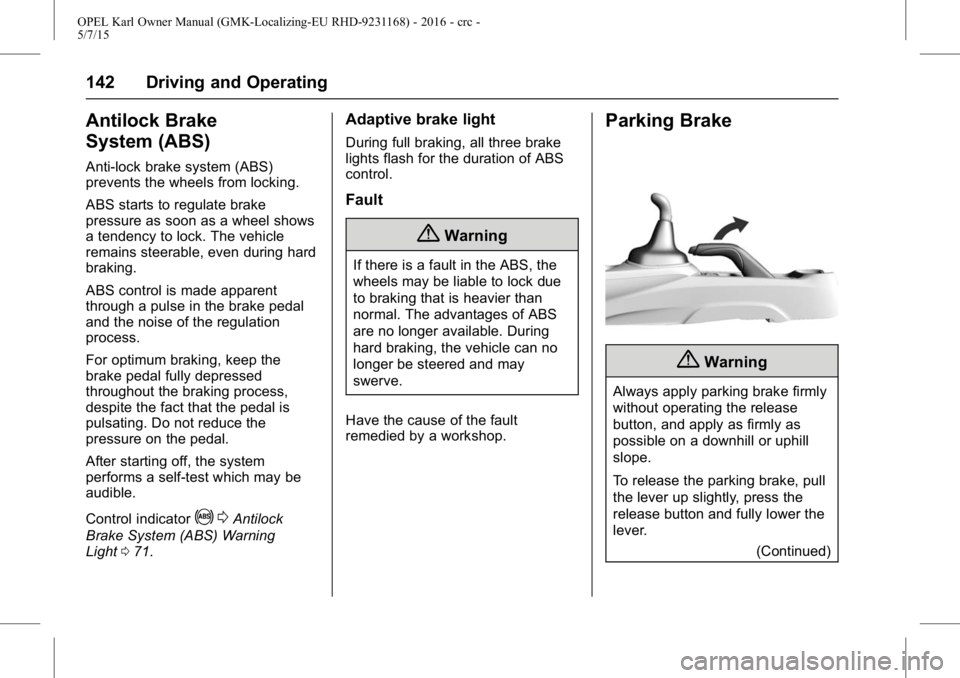
OPEL Karl Owner Manual (GMK-Localizing-EU RHD-9231168) - 2016 - crc -
5/7/15
142 Driving and Operating
Antilock Brake
System (ABS)
Anti-lock brake system (ABS)
prevents the wheels from locking.
ABS starts to regulate brake
pressure as soon as a wheel shows
a tendency to lock. The vehicle
remains steerable, even during hard
braking.
ABS control is made apparent
through a pulse in the brake pedal
and the noise of the regulation
process.
For optimum braking, keep the
brake pedal fully depressed
throughout the braking process,
despite the fact that the pedal is
pulsating. Do not reduce the
pressure on the pedal.
After starting off, the system
performs a self-test which may be
audible.
Control indicator
!0Antilock
Brake System (ABS) Warning
Light 071.
Adaptive brake light
During full braking, all three brake
lights flash for the duration of ABS
control.
Fault
{Warning
If there is a fault in the ABS, the
wheels may be liable to lock due
to braking that is heavier than
normal. The advantages of ABS
are no longer available. During
hard braking, the vehicle can no
longer be steered and may
swerve.
Have the cause of the fault
remedied by a workshop.
Parking Brake
{Warning
Always apply parking brake firmly
without operating the release
button, and apply as firmly as
possible on a downhill or uphill
slope.
To release the parking brake, pull
the lever up slightly, press the
release button and fully lower the
lever. (Continued)
Page 144 of 217
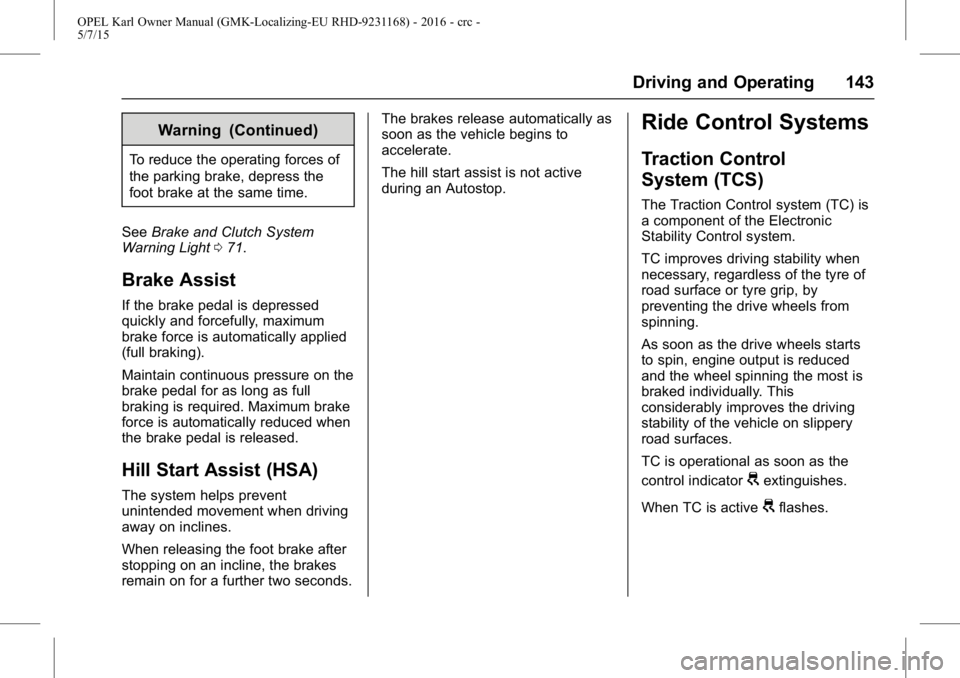
OPEL Karl Owner Manual (GMK-Localizing-EU RHD-9231168) - 2016 - crc -
5/7/15
Driving and Operating 143
Warning (Continued)
To reduce the operating forces of
the parking brake, depress the
foot brake at the same time.
See Brake and Clutch System
Warning Light 071.
Brake Assist
If the brake pedal is depressed
quickly and forcefully, maximum
brake force is automatically applied
(full braking).
Maintain continuous pressure on the
brake pedal for as long as full
braking is required. Maximum brake
force is automatically reduced when
the brake pedal is released.
Hill Start Assist (HSA)
The system helps prevent
unintended movement when driving
away on inclines.
When releasing the foot brake after
stopping on an incline, the brakes
remain on for a further two seconds. The brakes release automatically as
soon as the vehicle begins to
accelerate.
The hill start assist is not active
during an Autostop.
Ride Control Systems
Traction Control
System (TCS)
The Traction Control system (TC) is
a component of the Electronic
Stability Control system.
TC improves driving stability when
necessary, regardless of the tyre of
road surface or tyre grip, by
preventing the drive wheels from
spinning.
As soon as the drive wheels starts
to spin, engine output is reduced
and the wheel spinning the most is
braked individually. This
considerably improves the driving
stability of the vehicle on slippery
road surfaces.
TC is operational as soon as the
control indicator
Gextinguishes.
When TC is active
Gflashes.
Page 145 of 217
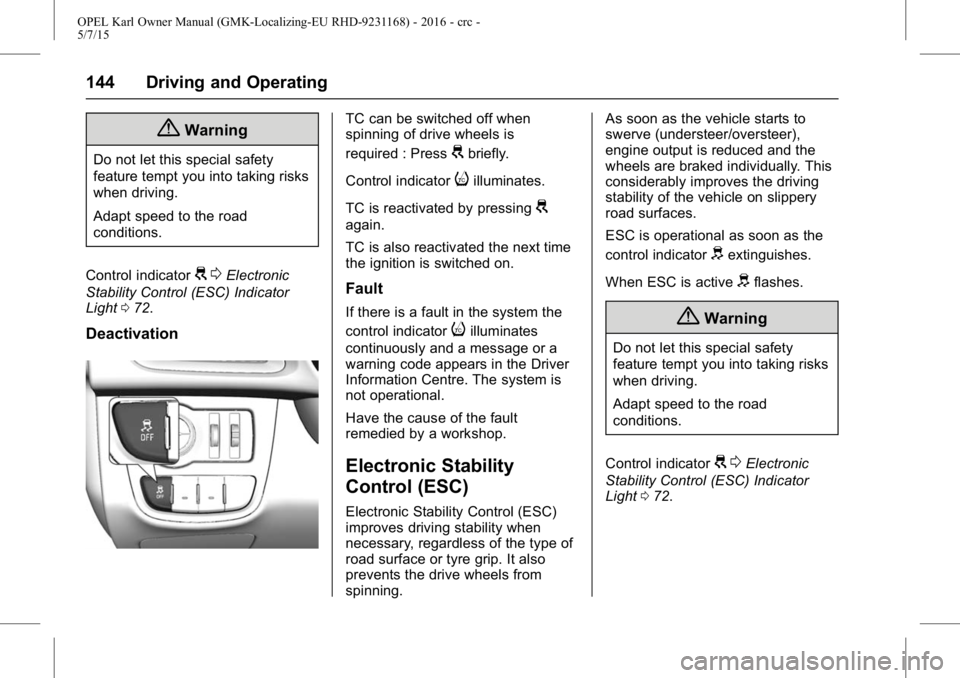
OPEL Karl Owner Manual (GMK-Localizing-EU RHD-9231168) - 2016 - crc -
5/7/15
144 Driving and Operating
{Warning
Do not let this special safety
feature tempt you into taking risks
when driving.
Adapt speed to the road
conditions.
Control indicator
G 0Electronic
Stability Control (ESC) Indicator
Light 072.
Deactivation
TC can be switched off when
spinning of drive wheels is
required : Press
Gbriefly.
Control indicator
iilluminates.
TC is reactivated by pressing
G
again.
TC is also reactivated the next time
the ignition is switched on.
Fault
If there is a fault in the system the
control indicator
iilluminates
continuously and a message or a
warning code appears in the Driver
Information Centre. The system is
not operational.
Have the cause of the fault
remedied by a workshop.
Electronic Stability
Control (ESC)
Electronic Stability Control (ESC)
improves driving stability when
necessary, regardless of the type of
road surface or tyre grip. It also
prevents the drive wheels from
spinning. As soon as the vehicle starts to
swerve (understeer/oversteer),
engine output is reduced and the
wheels are braked individually. This
considerably improves the driving
stability of the vehicle on slippery
road surfaces.
ESC is operational as soon as the
control indicator
dextinguishes.
When ESC is active
dflashes.
{Warning
Do not let this special safety
feature tempt you into taking risks
when driving.
Adapt speed to the road
conditions.
Control indicator
G 0Electronic
Stability Control (ESC) Indicator
Light 072.
Page 146 of 217
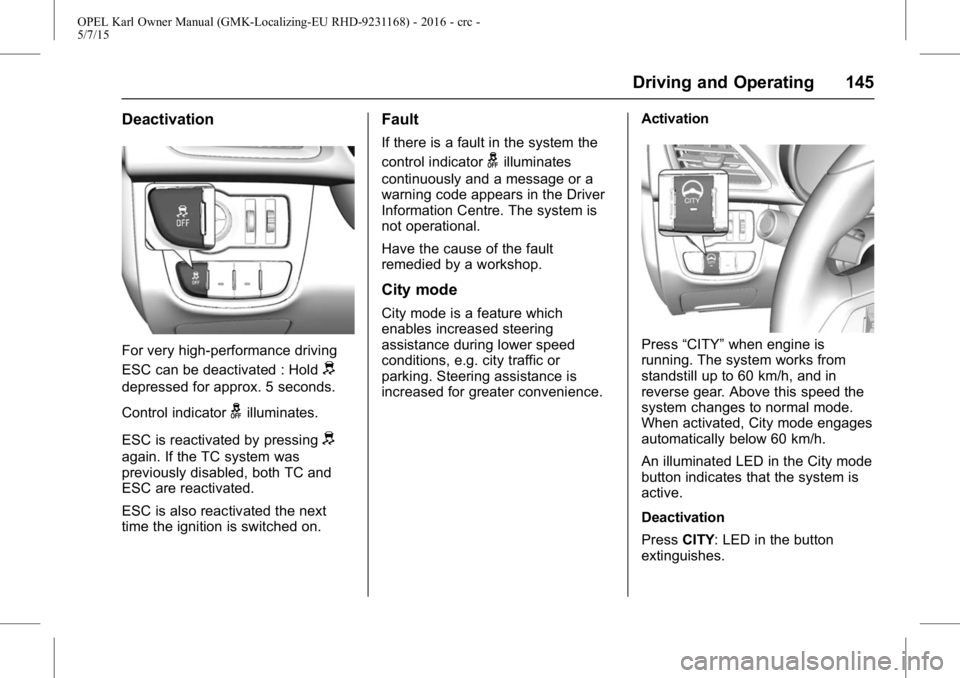
OPEL Karl Owner Manual (GMK-Localizing-EU RHD-9231168) - 2016 - crc -
5/7/15
Driving and Operating 145
Deactivation
For very high-performance driving
ESC can be deactivated : Hold
d
depressed for approx. 5 seconds.
Control indicator
gilluminates.
ESC is reactivated by pressing
d
again. If the TC system was
previously disabled, both TC and
ESC are reactivated.
ESC is also reactivated the next
time the ignition is switched on.
Fault
If there is a fault in the system the
control indicator
gilluminates
continuously and a message or a
warning code appears in the Driver
Information Centre. The system is
not operational.
Have the cause of the fault
remedied by a workshop.
City mode
City mode is a feature which
enables increased steering
assistance during lower speed
conditions, e.g. city traffic or
parking. Steering assistance is
increased for greater convenience. Activation
Press
“CITY” when engine is
running. The system works from
standstill up to 60 km/h, and in
reverse gear. Above this speed the
system changes to normal mode.
When activated, City mode engages
automatically below 60 km/h.
An illuminated LED in the City mode
button indicates that the system is
active.
Deactivation
Press CITY: LED in the button
extinguishes.
Page 147 of 217
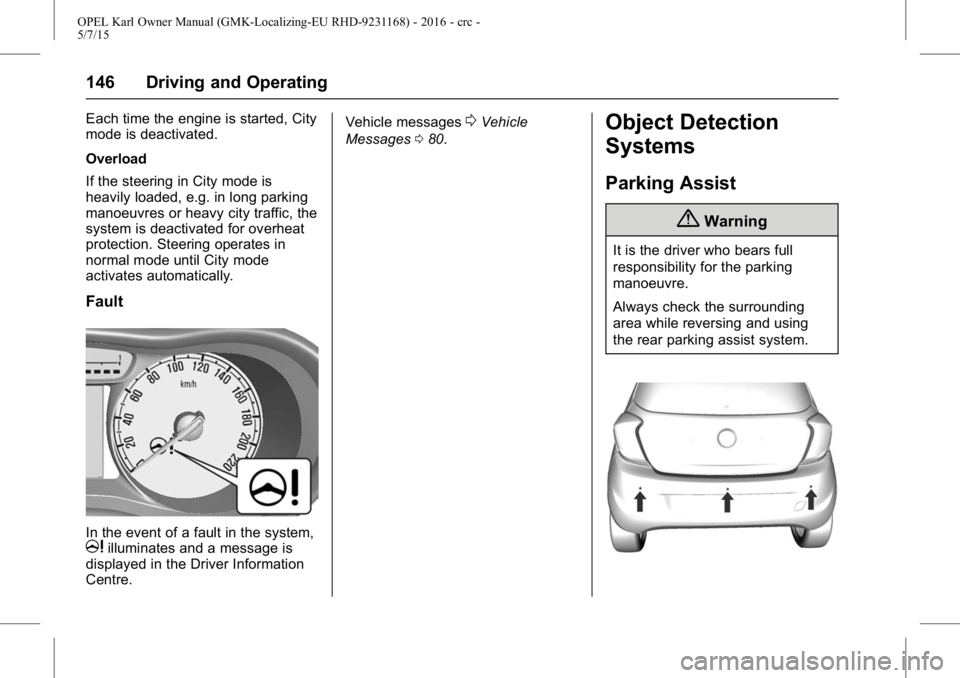
OPEL Karl Owner Manual (GMK-Localizing-EU RHD-9231168) - 2016 - crc -
5/7/15
146 Driving and Operating
Each time the engine is started, City
mode is deactivated.
Overload
If the steering in City mode is
heavily loaded, e.g. in long parking
manoeuvres or heavy city traffic, the
system is deactivated for overheat
protection. Steering operates in
normal mode until City mode
activates automatically.
Fault
In the event of a fault in the system,milluminates and a message is
displayed in the Driver Information
Centre. Vehicle messages
0Vehicle
Messages 080.Object Detection
Systems
Parking Assist
{Warning
It is the driver who bears full
responsibility for the parking
manoeuvre.
Always check the surrounding
area while reversing and using
the rear parking assist system.
Page 148 of 217
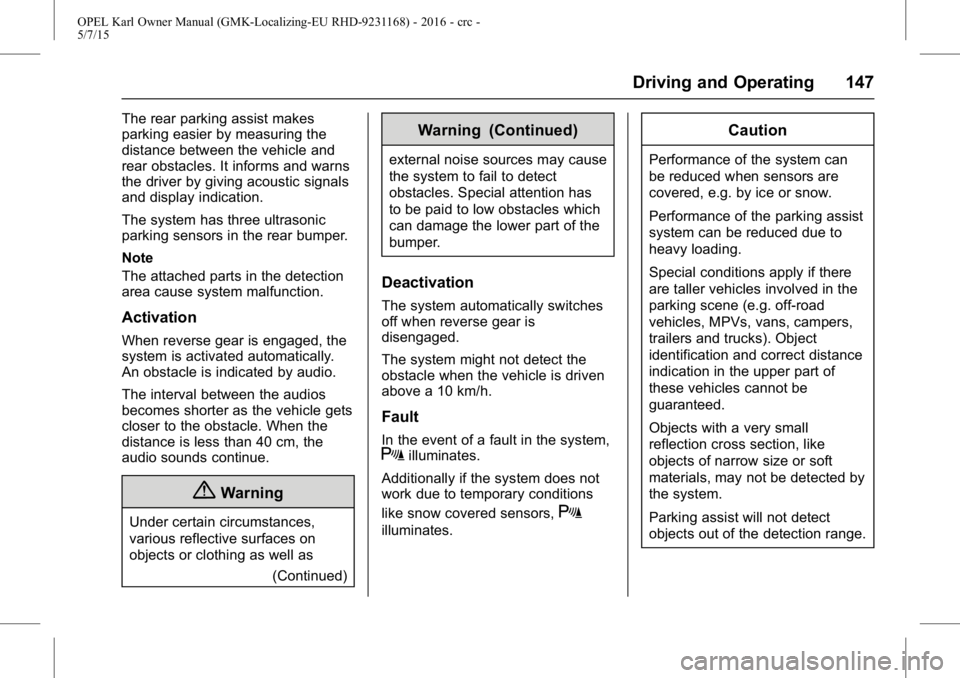
OPEL Karl Owner Manual (GMK-Localizing-EU RHD-9231168) - 2016 - crc -
5/7/15
Driving and Operating 147
The rear parking assist makes
parking easier by measuring the
distance between the vehicle and
rear obstacles. It informs and warns
the driver by giving acoustic signals
and display indication.
The system has three ultrasonic
parking sensors in the rear bumper.
Note
The attached parts in the detection
area cause system malfunction.
Activation
When reverse gear is engaged, the
system is activated automatically.
An obstacle is indicated by audio.
The interval between the audios
becomes shorter as the vehicle gets
closer to the obstacle. When the
distance is less than 40 cm, the
audio sounds continue.
{Warning
Under certain circumstances,
various reflective surfaces on
objects or clothing as well as(Continued)
Warning (Continued)
external noise sources may cause
the system to fail to detect
obstacles. Special attention has
to be paid to low obstacles which
can damage the lower part of the
bumper.
Deactivation
The system automatically switches
off when reverse gear is
disengaged.
The system might not detect the
obstacle when the vehicle is driven
above a 10 km/h.
Fault
In the event of a fault in the system,Xilluminates.
Additionally if the system does not
work due to temporary conditions
like snow covered sensors,
X
illuminates.
Caution
Performance of the system can
be reduced when sensors are
covered, e.g. by ice or snow.
Performance of the parking assist
system can be reduced due to
heavy loading.
Special conditions apply if there
are taller vehicles involved in the
parking scene (e.g. off-road
vehicles, MPVs, vans, campers,
trailers and trucks). Object
identification and correct distance
indication in the upper part of
these vehicles cannot be
guaranteed.
Objects with a very small
reflection cross section, like
objects of narrow size or soft
materials, may not be detected by
the system.
Parking assist will not detect
objects out of the detection range.
Page 149 of 217
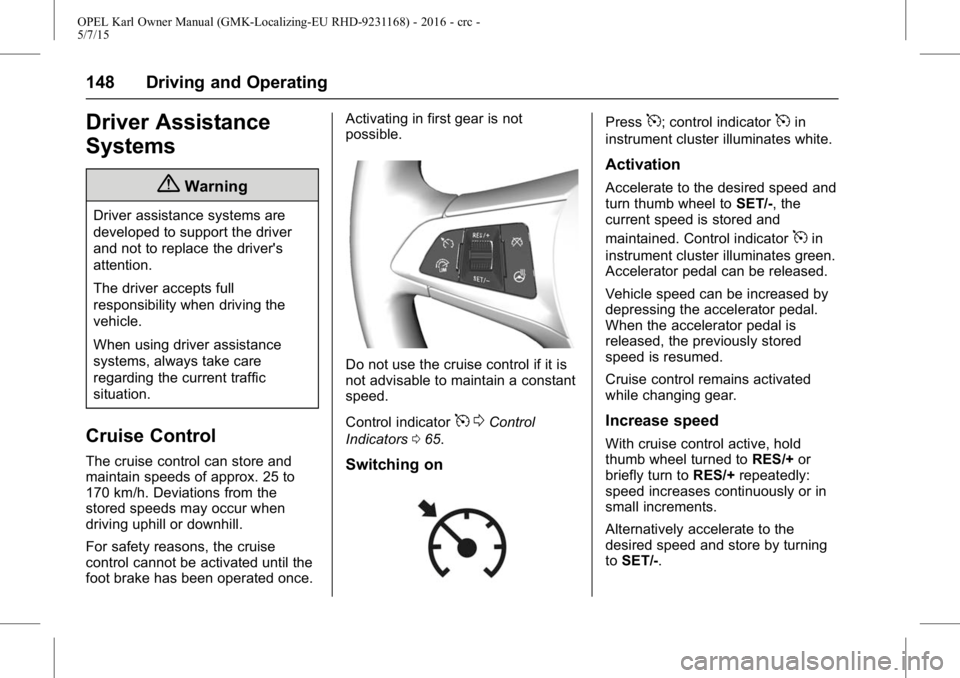
OPEL Karl Owner Manual (GMK-Localizing-EU RHD-9231168) - 2016 - crc -
5/7/15
148 Driving and Operating
Driver Assistance
Systems
{Warning
Driver assistance systems are
developed to support the driver
and not to replace the driver's
attention.
The driver accepts full
responsibility when driving the
vehicle.
When using driver assistance
systems, always take care
regarding the current traffic
situation.
Cruise Control
The cruise control can store and
maintain speeds of approx. 25 to
170 km/h. Deviations from the
stored speeds may occur when
driving uphill or downhill.
For safety reasons, the cruise
control cannot be activated until the
foot brake has been operated once.Activating in first gear is not
possible.
Do not use the cruise control if it is
not advisable to maintain a constant
speed.
Control indicator
5
0Control
Indicators 065.
Switching on
Press5; control indicator5in
instrument cluster illuminates white.
Activation
Accelerate to the desired speed and
turn thumb wheel to SET/-, the
current speed is stored and
maintained. Control indicator
5in
instrument cluster illuminates green.
Accelerator pedal can be released.
Vehicle speed can be increased by
depressing the accelerator pedal.
When the accelerator pedal is
released, the previously stored
speed is resumed.
Cruise control remains activated
while changing gear.
Increase speed
With cruise control active, hold
thumb wheel turned to RES/+or
briefly turn to RES/+repeatedly:
speed increases continuously or in
small increments.
Alternatively accelerate to the
desired speed and store by turning
to SET/-.
Page 150 of 217

OPEL Karl Owner Manual (GMK-Localizing-EU RHD-9231168) - 2016 - crc -
5/7/15
Driving and Operating 149
Reduce speed
With cruise control active, hold
thumb wheel turned toSET/-or
briefly turn to SET/-repeatedly:
speed decreases continuously or in
small increments.
Deactivation
Press*; control indicator5in
instrument cluster illuminates white.
Cruise control is deactivated. Last
used set speed is stored in memory
for later speed resume.
Automatic deactivation:
. Vehicle speed is below approx.
25 km/h. .
The brake pedal is depressed.
. The clutch pedal is depressed
for a few seconds.
. The selector lever is in neutral.
. Engine speed is in a very low
range.
. The Traction Control system or
Electronic Stability Control is
operating.
Resume stored speed
Turn thumb wheel to RES/+at a
speed above 25 km/h. The stored
speed will be obtained.
Switching off
Press5, control indicator5in
instrument cluster extinguishes. The
stored speed is deleted.
Pressing
sto activate the speed
limiter or switching off the ignition
also switches off cruise control and
deletes the stored speed.
Speed Limiter
The speed limiter prevents the
vehicle exceeding a preset
maximum speed.
The maximum speed can be set at
a speed above 30 km/h.
The driver can only accelerate up to
the preset speed. Deviations from
the limited speed may occur when
driving downhill.
The preset speed limit is displayed
in the Driver Information Centre
(DIC) when the system is active.
Activation